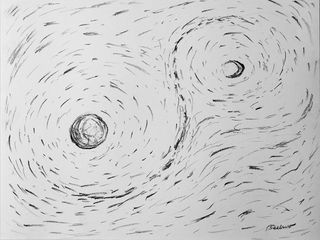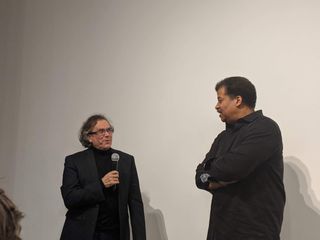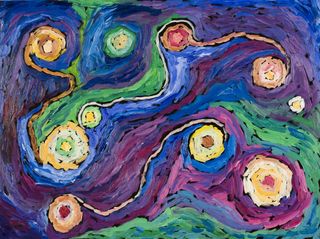Space and Art Collide in NYC Exhibit with Artist Ed Belbruno
Ed Belbruno lives in two worlds.

NEW YORK -- Ed Belbruno lives in two worlds. Both a mathematician who spent years developing innovative trajectories at NASA and an accomplished painter, Belbruno seems to inhabit the space between science and art.
Until the end of this week (on Nov. 22), you can check out some of Belbruno's artwork, which is featured as part of the Constellations in Color and Form science and space-inspired exhibition at Agora Gallery in New York City. The paintings Belbruno has on display in the exhibit are recent, from the past couple of years, he told Space.com at a Nov. 14 screening of "Painting the Way to the Moon," a documentary about Belbruno's journey through science and art, hosted by astrophysicist Neil deGrasse Tyson (who appears in the documentary).
Compared with some of his past work, this collection is strikingly abstract, while also being simplistic and powerful. "Typically my work is bold, it's one of my hallmarks," he said. "It's gotten much more abstract. I've gotten much more into using black: using black, however, with very bright colors of contrast."
Related: The Cosmic Art of Edward Belbruno (Gallery)

He added that he hasn't changed his artistic style and direction intentionally, it just evolved naturally. "I don't define the direction, the direction defines me," he said.
Belbruno's journey at both NASA and as an artist has been unconventional, to say the least. After hating math as a child, he cites a frightening drug experience (which he would not recommend, and which landed him in the hospital and on bed rest) as the beginning of his love of mathematics.
With his career at NASA, he pushed the boundaries of spaceflight by developing a unique ballistic trajectory that could get an object into lunar orbit with minimal fuel. During this time, however, Belbruno was also painting. In the documentary and at the gallery event, he even explained how drawing and painting helped him to actually devise the trajectory, as he experimented on a canvas with swirling, daring lines to connect the moon and Earth.
Get the Space.com Newsletter
Breaking space news, the latest updates on rocket launches, skywatching events and more!

Space and art
Belbruno is not the first to connect space and art. From Van Gogh's famous "Starry Night" painting to NASA astronaut Nicole Stott's "The Wave," which was the first watercolor painting done in space, there has been a cosmic connection to the arts for countless years.
But, while every artist might not have an inclination to dabble in science and math, Belbruno suggests that, just like he has found, those working in scientific fields could benefit from getting creative.
According to him, if people working in STEM (science, technology, engineering or math) fields "had the desire to do it [get into the arts], and wanted to do it and really felt that passion to do it, and did it with the intention of having it help their science work, it would do that."
It certainly did for Belbruno — at least he describes it this way. "The art, I think, is tapping a lot more creativity per second than the math is. So, when you take a break with the math for the art and go back to the math or the science, whatever you're doing, you have insights you never would have had before," he said.
- Alien Life, Landscapes and the Art of Space (Gallery)
- Do Science and Art Share a Source? - Café Panel Chat
- Lunar Inspiration: NASA's Moonbounce Art Project (Photos)
Follow Chelsea Gohd on Twitter @chelsea_gohd. Follow us on Twitter @Spacedotcom and on Facebook.

Join our Space Forums to keep talking space on the latest missions, night sky and more! And if you have a news tip, correction or comment, let us know at: community@space.com.

Chelsea “Foxanne” Gohd joined Space.com in 2018 and is now a Senior Writer, writing about everything from climate change to planetary science and human spaceflight in both articles and on-camera in videos. With a degree in Public Health and biological sciences, Chelsea has written and worked for institutions including the American Museum of Natural History, Scientific American, Discover Magazine Blog, Astronomy Magazine and Live Science. When not writing, editing or filming something space-y, Chelsea "Foxanne" Gohd is writing music and performing as Foxanne, even launching a song to space in 2021 with Inspiration4. You can follow her on Twitter @chelsea_gohd and @foxannemusic.
-
HopDavid Belbruno's much ballyhooed Hiten route only save about .2 km/s from Farquhar's route to EML2. And these so called weak stability boundaries aren't usable for interplanetary travel. See potholes on the interplanetary super highway.Reply
